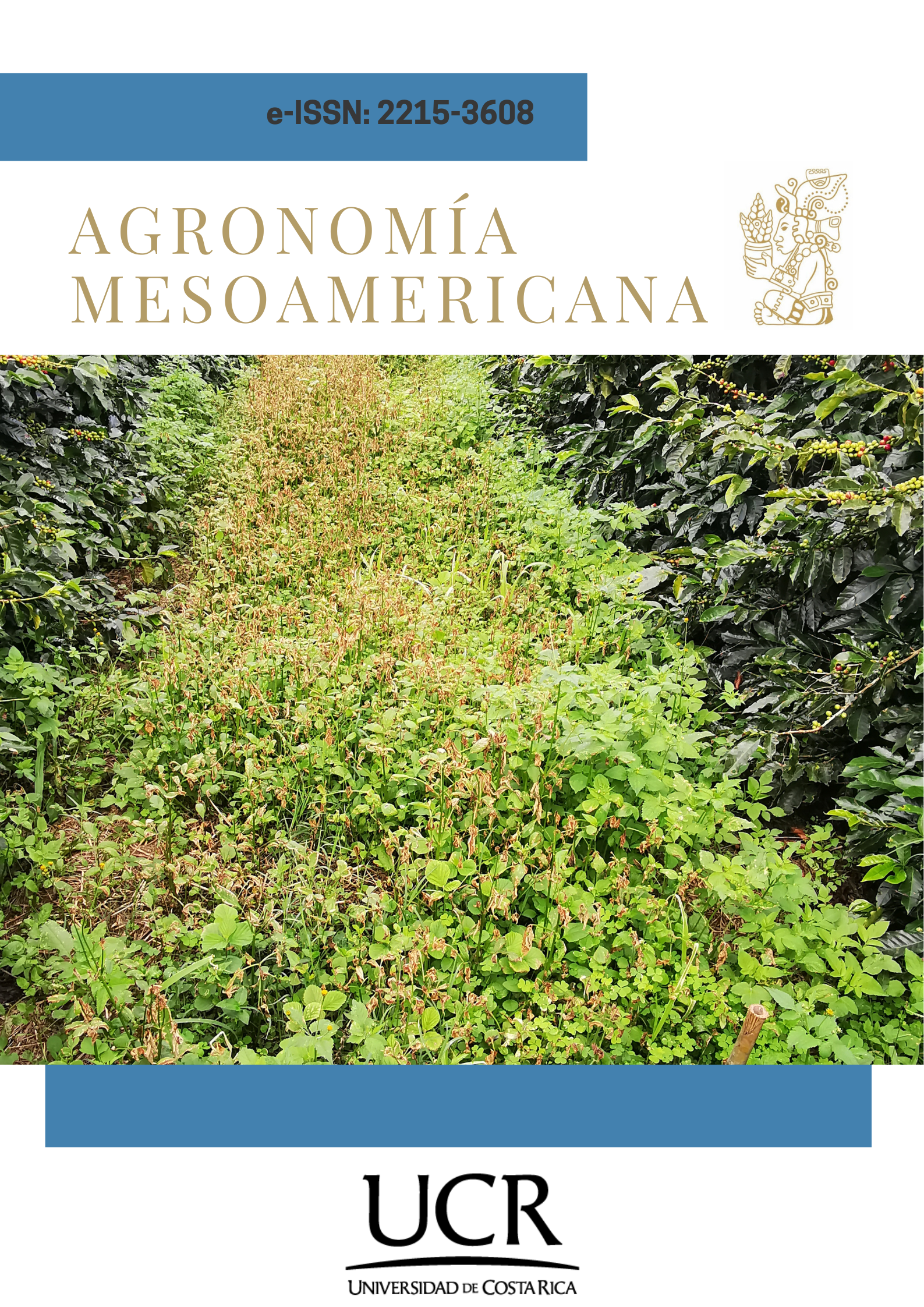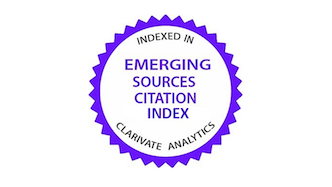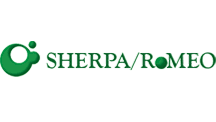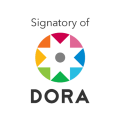Evaluation of ammonium nitrate and flaming for weed management in coffee
DOI:
https://doi.org/10.15517/am.2025.62524Keywords:
Commelina diffusa, propane, foliar fertilizer, herbicides, weed managementAbstract
Introduction. Weeds compete with coffee for water, light, and space; therefore, sustainable management practices must be implemented. Objective. To evaluate the effectiveness of weed management with ammonium nitrate and flaming in a coffee system. Materials and methods. This study was carried out from September 26, 2022, to January 10, 2023, at La Hilda coffee farm in San Pedro de Poás, Alajuela, Costa Rica. Two alternative weed control treatments were applied jointly: the first consisted of ammonium nitrate diluted in water at three doses (0, 150, and 300 kg/ha), followed 15 days later by flaming at three doses (0, 60, and 120 kg/ha). Applications targeted weeds present in the coffee rows, using a split-plot design where the main plot consisted of the ammonium nitrate doses and the small plots corresponded to flaming doses. A chemical control treatment with glyphosate, also combined with flaming, was included. Each treatment was randomly assigned and replicated six times. Results. Broad leaves were moderately damaged 25 days after nitrate application and 10 days after flaming. Both doses of ammonium nitrate without flaming caused slight damage to Commelina diffusa, and the highest ammonium nitrate dose without flaming produced moderate damage to broadleaf weeds; flaming without ammonium nitrate resulted in moderate initial damage to narrowleaf weeds. Conclusions. The herbicidal effect of ammonium nitrate was depended on flaming, but this effect was only observed in broadleaf weeds. C. diffusa was successfully controlled with glyphosate and flaming.
References
Agamalian, H. S. (1988). Weed control in crucifer crops with nitrogen fertilizers. California Agriculture, 42(6), 16–17.
Arcila, J., Farfán, F., Moreno, A., Salazar, L., & Hincapié, E. (2015). Sistemas de producción de café en Colombia. En H. F. Ospina, & S. M. Marín (Eds.), Las arvenses y su manejo en los cafetales (pp. 102–130). Centro Nacional de Investigaciones de Café.
Ascard, J. (1995). Thermal weed control by flaming: biological and technical aspects [Doctoral dissertation, Swedish University of Agricultural Sciences]. http://pub.epsilon.slu.se/3853/1/ascard_j_091026.pdf
Astatkie, T., Rifai, M. N., Havard, P., Adsett, J., Lacko-Bartosova, M., & Otepka, P. (2007). Effectiveness of hot water, infrared and open flame thermal units for controlling weeds. Biological Agriculture & Horticulture, 25(1), 1–12. https://doi.org/10.1080/01448765.2007.10823205
Bitterlich, I., Upadhyaya, M. K., & Shibairo, S. I. (1996). Weed control in cole crops and onion (Allium cepa) using ammonium nitrate. Weed Science, 44(4), 952–958. https://doi.org/10.1017/S0043174500094984
Centro de Investigaciones Agronómicas. (2021). Suelos CR (1.1.0) [Aplicación móvil]. App Store. https://apps.apple.com/cr/app/suelos-cr/id1550353003
Datta, A., & Knežević, S. Z. (2013). Flaming as an alternative weed control method for conventional and organic agronomic crop production systems: a review. Advances in Agronomy, 118, 399–428. https://doi.org/10.1016/B978-0-12-405942-9.00006-2
Flame Engineering, Inc. (2025). Weed Dragon® Torch Kits. Retrieved February 23, 2025. from https://flameengineering.com/collections/heavydutytorches
González Torres, A., Figueroa Viramontes, U., Preciado Rangel, P., Núñez Hernández, G., Luna Ortega, J. G., & Antuna Grijalva, O. (2016). Uso eficiente y recuperación aparente de nitrógeno en maíz forrajero en suelos diferentes. Revista Mexicana de Ciencias Agrícolas, 7(2), 301–309. https://doi.org/10.29312/remexca.v7i2.345
Henríquez, C., & Cabalceta, G. (1999). Guía práctica para el estudio introductorio de los suelos con un enfoque agrícola. Asociación Costarricense de la Ciencia del Suelo.
Huerta-Olague, J. de J., Oropeza Mota, J. L., Guevara Gutiérrez, R. D., Ríos Berber, J. D., Martínez Menes, M. R., Barreto García, O. A., & Mancilla Villa, O. R. (2018). Efecto de la cobertura vegetal de cuatro cultivos sobre la erosión del suelo. Idesia (Arica), 36(2), 153–162. http://dx.doi.org/10.4067/S0718-34292018005000701
Instituto Regional de Estudios en Sustancias Tóxicas. (2020). Manual de plaguicidas de Centroamérica. https://www.iret.una.ac.cr/index.php/es
Isaac, W.-A., Gao, Z., & Li, M. (2013). Managing Commelina species: Prospects and limitations. In A. J. Price, & J. A. Kelton (Eds.), Herbicides - Current Research and Case Studies in Use (pp. 543–562). IntechOpen. https://doi.org/10.5772/55842
Jhala, A. J., Knezevic, S. Z., Ganie, Z. A., & Singh, M. (2014). Integrated weed management in maize. In B. S. Chauhan, & G. Mahajan (Eds.), Recent Advances in Weed Management (pp. 177–196). Springer. https://doi.org/10.1007/978-1-4939-1019-9_8
Johnson, W. C., & Luo, X. (2018). Cool-season weed control using ammonium nonanoate and cultivation in organic Vidalia® sweet onion production. Weed Technology, 32(1), 90–94. https://doi.org/10.1017/wet.2017.91
Knezevic, S. Z., Stepanovic, S., & Datta, A. (2014). Growth stage affects response of selected weed species to flaming. Weed Technology, 28(1), 233–242. https://doi.org/10.1614/WT-D-13-00054.1
Montero Blanco, D. (2017). Manual de buenas prácticas de manejo en la fertilización nitrogenada del café. Fundecooperación para el Desarrollo Sostenible & Fondo Multilateral de Inversiones. https://www.mag.go.cr/bibliotecavirtual/AV-1419.pdf
Mortvedt, J. J. (2001). Calculating salt index. Fluid Jounal, 9(2), 8–11. https://fluidfertilizer.org/wp-content/uploads/2016/05/33P8-11.pdf
Ramírez Muñoz, F. (2021). El herbicida glifosato y sus alternativas (Serie Informes Técnicos IRET N° 44). Universidad Nacional, & Instituto Regional de Estudios en Sustancias Tóxicas. https://ipen.org/sites/default/files/documents/serie_tecnica_44_glifosato_1_1.pdf
Rifai, M. N., Astatkie, T., Lacko-Bartosova, M., & Gadus, J. (2002). Effect of two different thermal units and three types of mulch on weeds in apple orchards. Journal of Environmental Engineering and Science, 1(5), 331–338. https://doi.org/10.1139/s02-027
Rosskopf, E. N. (2017). Bio-herbicides: An overview. In R. Zimdahl (Ed.), Fundamentals of weed science (5th ed., pp. 367–399). Elsevier. http://dx.doi.org/10.19103/AS.2017.0025.20
Sierra, C. (1992). Características físicas y químicas de algunos fertilizantes [Boletín técnico]. Instituto de Investigaciones Agropecuarias. Recuperado marzo 20, 2022, de https://biblioteca.inia.cl/handle/20.500.14001/39239
Villalobos, A., & Herrera Murillo, F. (1999). Control químico de Polygonum aviculare y otras malezas en el cultivo de la zanahoria (Daucus carota). Revista de Agricultura Tropical, 32, 7–16.

Additional Files
Published
License

This work is licensed under a Creative Commons Attribution-NonCommercial-NoDerivatives 4.0 International License.
1. Proposed policy for open access journals
Authors who publish in this journal accept the following conditions:
a. Authors retain the copyright and assign to the journal the right to the first publication, with the work registered under the attribution, non-commercial and no-derivative license from Creative Commons, which allows third parties to use what has been published as long as they mention the authorship of the work and upon first publication in this journal, the work may not be used for commercial purposes and the publications may not be used to remix, transform or create another work.
b. Authors may enter into additional independent contractual arrangements for the non-exclusive distribution of the version of the article published in this journal (e.g., including it in an institutional repository or publishing it in a book) provided that they clearly indicate that the work was first published in this journal.
c. Authors are permitted and encouraged to publish their work on the Internet (e.g. on institutional or personal pages) before and during the review and publication process, as it may lead to productive exchanges and faster and wider dissemination of published work (see The Effect of Open Access).






























